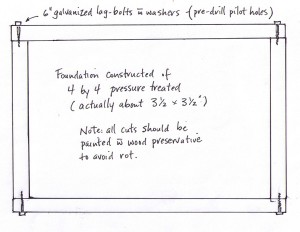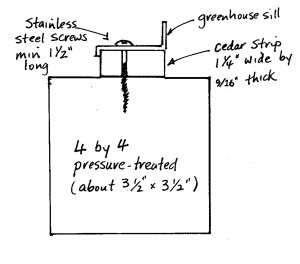Foundations
Foundation Sheet for Halls Magnum, Supreme and Popular Models
Russell Nursery, North Saanich, BC
Site Prep & Foundation document – Printable PDF
Materials list:
- Pressure-treated 4 by 4 lumber, see page two for the measurements for your model of greenhouse
- 4 Galvanized lag bolts 6” by ½” diameter and washers
- Stainless steel screws, 1 ½” long, pan-head (rounded head, not V-shaped)
- 4 to 6 pieces of ½” re-bar, 18” lon
- Cedar strips, 9/16” thick by 1 ¼” wide, enough to go under all four sides of the greenhouse.
- Landscape fabric to cover excavated area, overlap joins by 6 inches
A note on PT lumber:
Choose straight 4 by 4’s and make sure that at least one side is perfectly flat. You may have to look through a lot to find ones that aren’t too bowed. Mark the flat side (the face) and use it as the top of the surface to which you will attach the greenhouse.
Preparing the Site:
The foundation for your greenhouse will be constructed of 4 by 4 pressure- treated (PT) lumber held together with galvanized 6” x ½” lag bolts with washers. The PT 4 by 4’s will be nestled into a bed of crushed rock, but the tops of the 4 by 4’s must be higher than finished grade – use ¾ (or ½) inch clear crushed rock (drain rock) for the foundation pad. In most cases the crushed rock serves as the floor of the greenhouse, but some people put pavers in the centre as a walkway.
How deep should the crushed rock be? Four to six inches is ideal. Remove sod and loose organic material down to undisturbed ground. Putting down landscape fabric before you place the gravel is generally a good idea.
How large should the pad of crushed rock be? So that you can easily walk around the greenhouse to clean and maintain it, plan for a pad that is about 18” larger on all sides than the nominal size of your greenhouse. For example, a 12 by 8 greenhouse would have a pad about 15 by 11 feet. If the site is not level, you may need extra 4 by 4’s or landscape ties as a retaining wall, to level the area and hold the rock in place. Using crushed rock allows you to make minor adjustments to get the foundation level and provides good drainage so that the foundation is not sitting in water.
How do I know how much crushed rock to order? Rock, soil and bark mulch are calculated in cubic yards, in this allegedly metric country. A cubic yard is 3 ft by 3 ft by 3 ft or 27 cubic feet. Example: You have an 86 (8 ft by 6 ft) greenhouse and you need to fill in an area four inches deep. Adding 18” on all four sides gives you a pad size of 11 by 9 or 99 square feet. 99 divided by 3 (because 4 inches is one third of a foot) equals 33 cubic feet of rock or just a little more than a cubic yard, so get a yard and a half to have some extra.
Assembling the Foundation: Pre-drill a 6″ long x 3/8″ pilot hole through near each end of the two sides. Then use a 1/2″ diameter bit to drill through the first 4×4 only, leaving the inside 4×4 with the smaller pilot hole for the lag bolt to thread tightly. Treat any cut ends of the PT lumber to guard against rot.
Once the 4 by 4’s are bolted together and are in place, use a 4′ or 6′ level determine your lowest spot and decide if you need to raise or lower the foundation to ensure it is perfectly level. It works best if the 4 by 4 is mostly buried in the bed of crushed rock, so that the door is just slightly above grade.
The greenhouse frame will be secured to this base with pan-head stainless steel screws. The frame should not actually touch the PT lumber as the preservatives can corrode aluminum, so it sits on a cedar strip 1 ¼” wide by 9/16” thick. Don’t skip this step: it’s important for other reasons as well
It is important that the foundation be level and square. A long builder’s level is useful for this, and you can see if you are out-of-square by measuring across on the diagonals, as in the diagram. Corner to corner measurements should be the same. If one measurement is shorter by, say 3/4″, tap (rack) the longer corner by 3/8″. Check again to ensure equal measurements.
Securing the Foundation to the ground:
Once the foundation is in place and you are happy that it is level and square, you will need to secure the foundation to the ground, particularly in exposed, windy sites. On the longest 4 by 4’s, about a foot from the ends, drill pilot holes, not straight down but at about a 45 degree angle, then drive an 18 inch piece of ½” diameter re-bar through the 4 by 4 and into the ground. (An angled pin is much stronger than one that goes straight down into the ground.) The hole at the other end should be drilled at the opposite angle thereby securing the greenhouse strongly, no matter which direction the wind is blowing. Four pins on an 8 by 6 ft house are adequate, more on a larger one. For 128 and 148 houses, we usually add a third pin in the middle of each side.
What Are the Dimensions of my Foundation?
See the chart below for the model of greenhouse you have. The chart shows the outside dimensions of each greenhouse and the outside dimensions of the 4 by 4 foundation are on the right hand side of the chart below. The dimensions for the foundation will allow you to place the frame more or less in the middle of the four by four, with about an inch of extra space all around.
Once the foundation is in place (and did I mention that it has to be level and square?) and the frame of the greenhouse is bolted together, position it on the foundation, then lift it up and place the 1 ¼’ by 9/16” cedar strips underneath the sill. Next, use 1 ½ inch pan-head stainless steel screws to secure the sill to the foundation. Each bay of the greenhouse is two feet wide. Pre-drill through the aluminum sill and place a screw in the center of each bay, but offset the holes slightly towards the outside edge, so that when you put on the glass, the panes do not sit on a screw-head. Screw down the gable ends first and then the sides, and make sure there is no bowing in the greenhouse sill. Use a long straight-edge or board along the sides to see if they are straight before you screw them to the foundation. Note: the holes that you drill through the sill plate are the only ones you have to drill for your greenhouse installation.
| Model | Greenhouse Length | Greenhouse Width | Foundation Length | Foundation Width |
|---|---|---|---|---|
| Magnum 108 | 10′ 6 3/4″ / 3.22m | 8′ 5 3/16″ / 2.57m | 10′ 8 3/4″ / 3.27m | 8′ 7 3/16" / 2.62m |
| Magnum 128 | 12′ 7 3/16″ / 3.84m | 8′ 5 3/16″ / 2.57m | 12′ 9 3/16″ / 3.89m | 8′ 7 3/16" / 2.62m |
| Magnum 148 | 14′ 7 9/16″ / 4.46m | 8′ 5 3/16″ / 2.57m | 14′ 9 9/16″ / 4.51m | 8′ 7 3/16" / 2.62m |
| Popular 46 | 4′ 3 5/8″ / 1.31m | 6’4″ / 1.93m | 4′ 5 5/8″ / 1.36m | 6′ 6″ / 1.98m |
| Popular 86 | 8′ 5 3/16″ / 2.57m | 6’4″ / 1.93m | 8′ 7 3/16″ / 2.62m | 6′ 6″ / 1.98m |
| Popular 106 | 10′ 5 5/8″ / 3.19m | 6’4″ / 1.93m | 10′ 7 5/8″ / 3.24m | 6′ 6″ / 1.98m |
| Supreme 46 | 4′ 4 3/8″ / 1.33m | 6’4″ / 1.93m | 4′ 6 3/8″ / 1.38m | 6′ 6″ / 1.98m |
| Supreme 86 | 8′ 5 3/8″ / 2.57m | 6’4″ / 1.93m | 8′ 7 3/8″ / 2.63m | 6′ 6″ / 1.98m |
| Supreme 108 | 10′ 6″ / 3.20m | 8′ 4 3/8″ / 2.55m | 10′ 8″ / 3.25m | 8′ 6 3/8″ / 2.6m |
| Supreme 128 | 12′ 6 3/4″ / 3.83m | 8′ 4 3/8″ / 2.55m | 12′ 8 3/4″ / 3.88m | 8′ 6 3/8″ / 2.6m |
| Supreme 148 | 14′ 7 5/8″ / 4.46m | 8′ 4 3/8″ / 2.55m | 14′ 9 5/8″ / 4.51m | 8′ 6 3/8″ / 2.6m |


